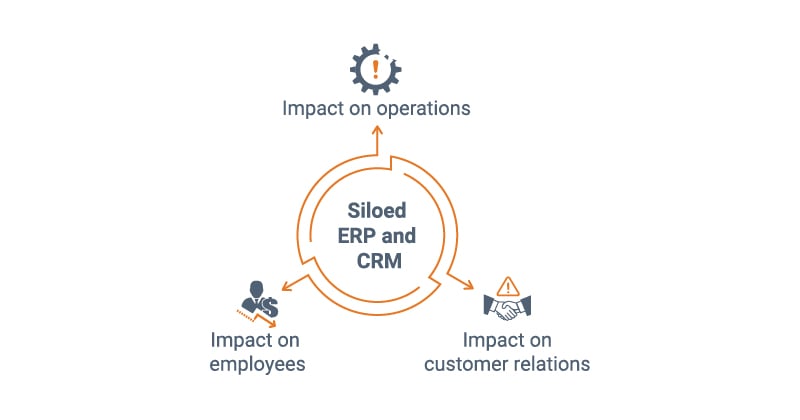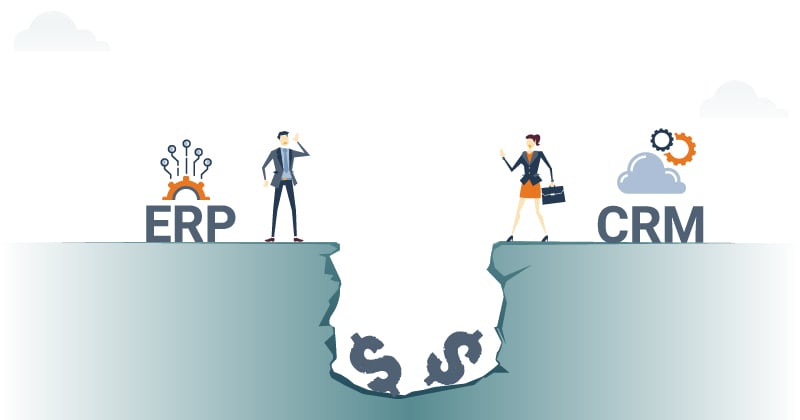Implementing ERP and CRM is usually the first step a company takes toward digital transformation. Rental businesses can manage operations and consolidate communications better with the two technologies.
While both ERP and CRM are great technologies, a disconnect between the two can be harmful, especially for the equipment rental industry.
The last thing you’d want as a rental business is to give a delayed quote due to not having instant insights into the pricing, resulting in a dissatisfied client or, worse — a lost customer!
Having worked with rental and manufacturing businesses across multiple industries and geographies, we at To-Increase know the significance of connecting ERP and CRM operations for rental businesses. It ensures quick information access with a unified view, saving you the time and effort of having multiple teams involved in the journey of a rental asset.
This article will discuss the challenges rental companies face with siloed ERP and CRM systems, their impact on your business, and show you a possible solution.
What are the top 5 challenges of a disconnected ERP and CRM for rental companies?
1. Checking customer information in multiple systems due to a lack of unified visibility
With disconnected ERP and CRM, the rental business’s sales and marketing teams must log into and always maintain two separate systems. Vital information regarding the customer such as customer communication, rental order tracking, and order changes or updates must be checked in two independent systems.
2. Longer time to close sales as you respond to customers slowly
When the rental sales team is dealing with a customer looking to rent equipment or products from your company, they must have access to all the necessary information instantly.
However, with siloed ERP and CRM, they track customer information in the CRM and must obtain other data related to rental pricing, checking the availability of equipment, and customer requests (servicing, replacement, or ordering additional equipment) from the ERP.
This constant back and forth negatively impacts customer response time.
3. Data duplication causing errors due to a lack of process automation
Since there is no sync in relevant sales, finance, and supply chain information — data related to quotes, contracts, and invoices must be entered manually by the rental account manager and the rental representative, making the process time-consuming.
There is a duplication of effort, with the need to manually populate multiple systems. This manual data entry could lead to errors, which in the worst case could mean quoting incorrect pricing or assigning already booked rental equipment.
4. No uniformity in rental orders with disparate data across systems
Since the data entry process is repetitive and prone to errors, the way data is entered could differ in the ERP and CRM systems. This simply means that a rental order logged in as ‘automotive’ in the ERP could be logged in as ‘car’ in the CRM, leading to disparate data across your information systems.
A single error or change in either of the systems could impact both systems in use. This becomes taxing when you’d want to examine the end-to-end history of a particular asset, as it is named or logged differently in different systems.
5. Difficulty forecasting rentals due to a lack of insights on utilization
With the rental sales and marketing team not having complete access to integral information regarding their customers’ renting behavior, they cannot make informed decisions in the future on positioning their rental assets.
What is more, reports must be generated from pipelines in both the systems, then collated to get some insights into the asset performance of your rental fleet or inventory.
This makes future financial investment on which assets to purchase or manufacture more difficult, impacting the overall revenue of your rental business.
What is the impact of siloed ERP and CRM on rental companies?
Apart from the challenges discussed above, there are three major areas that are negatively impacted by unorganized data in two separate ERP and CRM systems.
1. Impact on operations: All the above challenges lead to mismanaged data flow and data loss, leading to prolonged processes. This is critical to address as the rental industry demands a quicker response regarding equipment breakdowns or shortages.
2. Impact on employees: According to a global research study, workers waste more than 40 percent of their day on manual digital administrative processes. The additional effort in data entry and tracking could lead to digital burnout among employees as the process requires a lot of their time and affects their productivity.
3. Impact on customer relations: Needless to say, the above two will directly influence the experience you offer to your customers. Repeated issues associated with rental quotes or agreements could lead to disgruntled customers and increase customer churn.
How can you eliminate silos between your ERP and CRM?
One solution to address all the above-mentioned challenges would be to connect your ERP and CRM systems.
Such a solution offers bidirectional data flow with a unified view of information. Your employees can access relevant information stored in the ERP within the CRM itself through an ‘information sync’ as the two systems would be connected.
It increases collaboration among several departments, resulting in efficient communication and a quicker turnover, making the life of your employees easier.
Additionally, with connected ERP and CRM, the potential of information readily available for various teams in the rental companies is tremendous. If you’re looking to be proactive and agile among your competitors, then perhaps you’d want to consider the solution of having both your ERP and CRM handled and managed on a single platform.
Is it possible to connect your ERP and CRM on a single platform?
The short answer is yes.
However, the ideal solution would have rental-specific information, with both the ERP and CRM systems handled by a single platform. This makes overall maintenance easier and reduces the number of contacts you’ll have to reach out to.
If you’re interested in Microsoft Dynamics 365 or are an existing Dynamics user, you could explore the rental software we offer — DynaRent, embedded in the Dynamics 365 Finance and Supply Chain Management environment and manages the end-to-end rental lifecycle from lead-to-cash with a CRM add-on.
The CRM add-on, DynaRent for D365 Sales, connects to the DynaRent ERP and provides direct access to rental-specific information.
What can you do to transform your rental business today?
You’ve now understood the significance of connected ERP and CRM systems for your rental business. The next steps you could take:
- Check your existing ERP and CRM systems and gauge the options you have for connecting them
- Investigate if you want to invest in a single platform such as Dynamics for both your ERP and CRM
- Explore the concept of rental-specific software that offers you relevant information regarding the rental lifecycle in both the ERP and CRM systems
Once you’ve figured out the above, you will have a clearer picture of what steps you could take to transform your rental business digitally.
If you’re curious to explore more about the rental-specific software we offer, then you could check out the solution factsheet.
This factsheet shares information on:
- How you can generate quotes quickly and close deals faster
- How DynRent supports your lead-to-cash process
- The benefits of the solution to each team member in your rental company
- The features and offerings of the software





